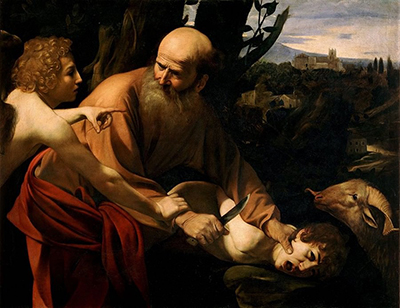Sacrifice of Isaac is an oil on canvas work painted in Carivaggio's trademark chiaroscuro style.
It depicts the sacrifice of Isaac by Abraham as written in Genesis 22, with some artistic variations.
In Caravaggio's version, Abraham prepares to kill his son under God's guidance by knife—rather than fire—but is rescued just in time by an angel on the left.
The use of light and shadow draws attention to Abraham's right hand and his pointed blade, with the three subjects surrounding in a well orchestrated radial position.
Posthumous identification has found that Abraham was modelled by Cecco Boneri—frequently depicted by Caravaggio—and Isaac is modelled by the same child as in his famed painting The Amor (1602). This reliance on models gives the painting an aura of authenticity, particularly regarding the angel whose wings are the only indication of a spiritual nature.
Michelangelo Merisi de Caravaggio (1571 - 1610) (not to be confused with Michelangelo) was an Italian master painter who, along with Agostino and Annibale Carracci, helped formulate the Baroque period and style of painting.
Caravaggio's paintings are renowned for their combination of realism with harsh chiaroscuro. Chiaroscuro (later developed into tenebrism) is a technique in oil painting developed in the Renaissance, which uses vivid tonal contrasts between light and dark to exaggerate and bring a painting's three-dimensional forms to the fore.
Caravaggio worked almost exclusively in this harsh and dramatic style, often working directly on his canvas with live posed models rather than drawing from ideal forms or sketches. This reliance on reality and naturalism gave his work a sharp and controversial edge when depicting Biblical or spiritual themes. His work was extremely influential for the Baroque period, impacting many renowned painters from Rembrandt to Rubens.
Caravaggio worked as a painter from a young age, undertaking an apprenticeship with the painter Simone Peterzano in 1584. Although born in Milan, Caravaggio travelled widely and eventually moved to Rome in 1592 to start his career as an independent artist. These years—sometimes called his "Rome Years"—saw Caravaggio rise from a lowly workshop painter to an esteemed and prestigious artist in his own right.
Caravaggio's breakthrough came with commissions made by the Catholic Church for stylistic paintings for their churches and palazzos. This was a period of distinct threat and violence between Protestantism and Catholicism, with the Catholic Church consolidating cultural and social power with the commissioning of art.
Among Caravaggio's successes in Rome were a series of commissions for the Contarelli Chapel in the church of San Luigi dei Francesi in 1600. These created a sensation in Rome and provided a platform through which to accept numerous other proposals from private and public patrons. Sacrifice of Isaac is one such commission, completed in 1603 for the Cardinal Maffeo Barberini, the future Pope Urban VIII. Caravaggio was paid 100 Italian scudi for the work which followed a previous commission, a Portrait of Maffeo Barberini (1598).




